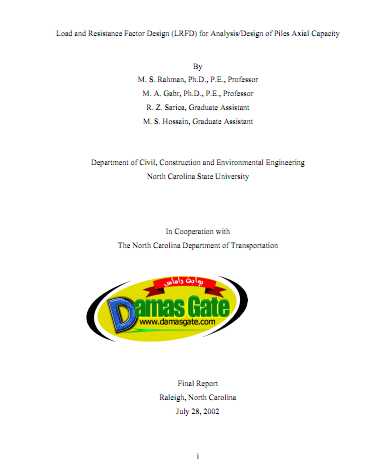Load and Resistance Factor Design (LRFD) for Reliability AnalysisDesign of Piles Axial Capacity

Load and Resistance Factor Design (LRFD) for Analysis/Design of Piles Axial Capacity
By M. S. Rahman, Ph.D., P.E., Professor
M. A. Gabr, Ph.D., P.E., Professor R. Z. Sarica, Graduate Assistant M. S. Hossain, Graduate Assistant
Department of Civil, Construction and Environmental Engineering North Carolina State University
In Cooperation with The North Carolina Department of Transportation
Disclaimer: The contents of this report reflect the views of the author(s) and not necessarily the views of the University. The author(s) are responsible for the facts and the accuracy of the data presented herein. The contents do not necessarily reflect the official views or policies of either the North Carolina Department of Transportation or the Federal Highway Administration at the time of publication. This report does not constitute a standard, specification, or regulation.
1.1 BACKGROUND
Driven piles are one of the main elements of bridge foundations. Currently, North
Carolina Department of Transportation (NCDOT) uses static methods of design of the
foundation piles with the conventional factor of safety (referred to as Allowable Strength
Design). In addition Wave Equation Analysis is used to provide the pile driving criteria,
which show the required hammer blow counts for achieving the pile design capacity.
Static load tests and Pile Driving Analyzer (PDA) are sometimes used to verify the
design. The American Association of State Highway and Transportation Officials
(AASHTO) has called for the implementation of Load and Resistance Factor Design
(LRFD) for bridges including their foundations. Presently, virtually all reinforced
concrete superstructures are designed using LRFD method, and steel design is in the
process of transition from the Allowable Strength Design (ASD) code to the newer LRFD
code.
Download
*